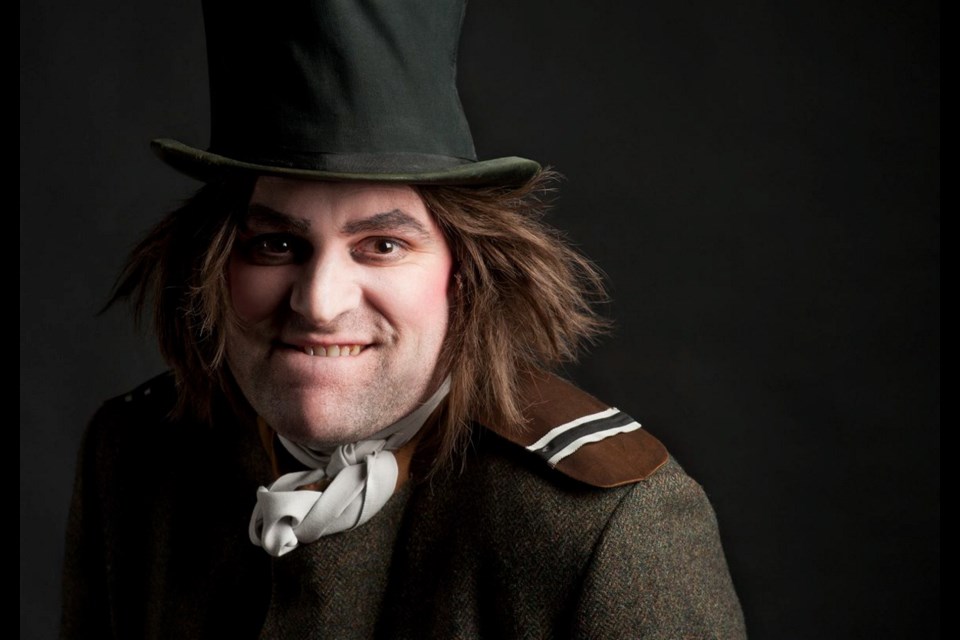REVIEW
What: Les Misérables
Where: McPherson Playhouse
When: Until May 10
Tickets, info: 250-386-6121
Rating: Five stars out of five
You say you want a revolution? Few mega-musicals provide one with as much rage, bombast and pathos as Les Misérables. Indeed, is there anyone who hasn’t seen Alain Boublil and Claude-Michel Schönberg’s adaptation of Victor Hugo’s 19th-century novel, especially since the 2012 movie in which Anne Hathaway starred?
You haven’t seen Les Misérables done like this, however. Victoria Operatic Society’s production of the theatrical marathon is a singular sensation. While the “amateur theatre” label often lowers expectations, this assumption seems particularly unfair here. This is a masterful accomplishment by any standard.
From the moment a bearded Jeffrey Stephen appears raging against injustice in prison in Toulon, France, in 1815, he commands our attention. He imbues Jean Valjean, the French peasant condemned to two decades of hard labour for stealing a loaf of bread, with palpable passion and conviction. Portraying “prisoner 24601” and his redemptive journey across France, with fanatical Insp. Javert in relentless pursuit, is a Herculean task Stephen pulls off with aplomb.
He convincingly morphs from the victimized inmate who resolves to put his criminal past behind him, starting with his passionate rendition of Valjean’s angry soliloquy, to his new life as a leading citizen. Valjean assumes the identity of a wealthy factory owner who protects Fantine, the ill-fated single mother forced into prostitution, and vows to raise her orphaned daughter, Cosette.
The tenor’s voice is put to the test and, hearing him seamlessly switch octaves — notably during his achingly beautiful rendition of Bring Him Home, sung in falsetto and infused with raw emotion — is mind-blowing.
Chris Newstead proves a worthy nemesis, impressively capturing Javert’s tenacity and proving a far better singer than Russell Crowe was on screen.
His glowering avenger seethes with rage, whether dismissing the red light district as “a nest of whores and vipers,” or contemplating his fate on a moonlit bridge in his climactic soliloquy Javert’s Suicide.
The sheer magnitude of this production makes it challenging to compress its assets. Chief among them are director-choreographer Matthew Howe’s staging. By turns pragmatic and inventive, it shrewdly balances the emotion that’s always at risk of being dwarfed by melodramatic spectacle and the need to keep this three-hour show captivating by moving it along.
There’s a beautiful synergy between Howe’s direction and the show’s technical attributes. Particularly notable are his stunning visual tableaux, from the opening sight of hunched prison inmates marching, to darkly evocative images of Stephen’s conflicted fugitive carrying a wounded Marius through the Paris sewers.
Who needs the original’s turntable set when you have a backdrop as stunning as Bill Adams’s multi-functional, period-specific set on a raked stage?
This angular assemblage combines artfully textured, earth-toned buildings with coved doorways linked by a striking grey bridge (over the River Seine), depicting locales including the Paris sewers, a Montreuil factory and Valjean’s future home. The clever use of flyaway, interlocking panels and accoutrements, such as an illuminated cross or glowing rouge panels as windows to evoke the red light district, enhance the illusion.
Veteran lighting designer Adam Wilkinson outdoes himself here through his creative use of atmospheric colours, and spotlights that isolate characters on a smoke-suffused stage during solos.
His innovation beautifully matches the set design. It illuminates, for example, Adams’ ingenious use of a translucent mobile panel bearing artistic renditions of upturned chairs, tables, bedposts and so on to represent the barricade. It’s a standout during Howe’s evocation of the ill-fated 1832 Paris Uprising, accented by an eye-popping fusion of smoke and flame-belching muskets.
Supporting a huge ensemble cast whose big choral numbers such as One Day More are spine-tingling, the show’s 12-piece orchestra, conducted by musical director Heather Burns, is a major asset as it revives one familiar anthem after another.
While Angela Ireland clearly has the musical chops to play Fantine, her lovely voice overshadows her character’s dramatic requirements. Ireland’s strengths are most obvious during her soaring rendition of Fantine’s signature song I Dreamed a Dream, and the delicacy she displays in her reprisal of Come to Me, her deathbed duet with Valjean.
Desirae Barkman is mournfully affecting as Eponine, tormented by her unrequited love for student revolutionary Marius, who is nicely played and sung by Ethan Otto, most beautifully during his Empty Chairs at Empty Tables lament. Barkman’s sterling rendition of the melancholic ballad On My Own is another high point.
As the grownup Cosette who steals the fallen soldier’s heart, soprano Rebecca Thackray exudes a fetching purity.
Other standouts include Griffin Lea, vigorously evoking the unbridled passion of student rebellion leader Enjolras, and Dwayne Gordon, whose robust vocals are effectively showcased as the Bishop of Digne.
Fine, too, are youngsters Zentaya Ellis and Cailea Gordon as young Cosette and Eponine, respectively, and Jordan McDonald, a scene-stealer as plucky urchin Gavroche.
While some of the script’s dramatic excess arguably deserves the guillotine, the Thenardiers, the scheming innkeepers whose rollicking Master of the House recalls Oliver!, provide welcome comic relief.
Some of Howe’s cleverest choreography, including a string of sausages doubling as a buffoon’s scarf and necklace, enlivens sequences showcasing the inspired clowning of an over-the-top Stephanie Sartore as she flounces about, and Quinn Stevens, strutting as if he were channelling Fagin on laughing gas, as her crazed partner in crime.


-thumb.png;w=120;h=80;mode=crop)
